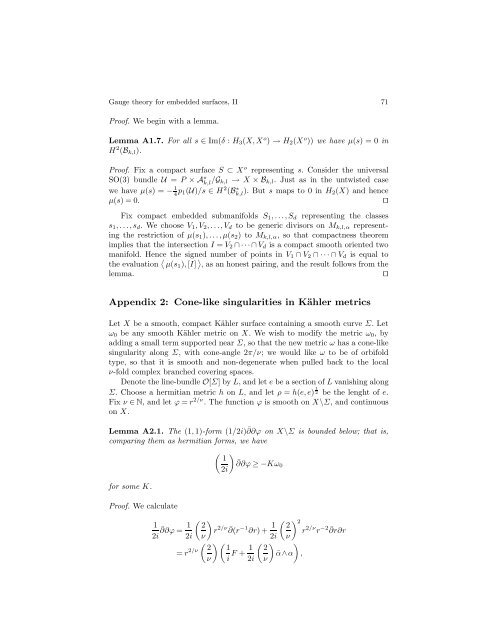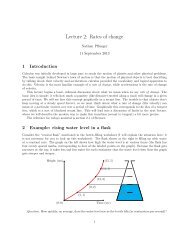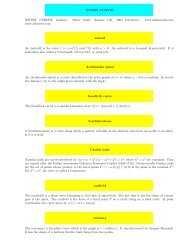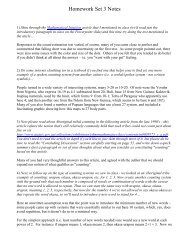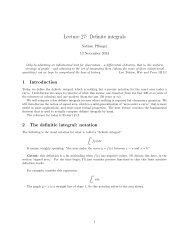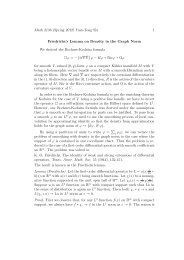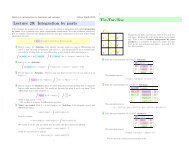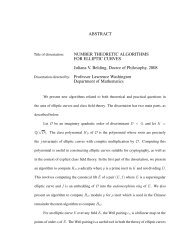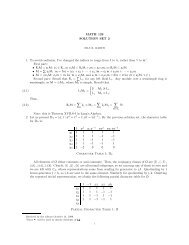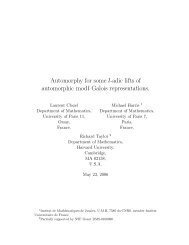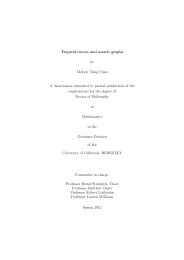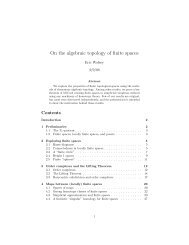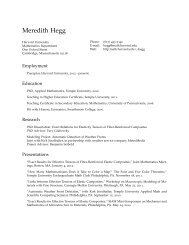Gauge theory for embedded surfaces, II
Gauge theory for embedded surfaces, II
Gauge theory for embedded surfaces, II
Create successful ePaper yourself
Turn your PDF publications into a flip-book with our unique Google optimized e-Paper software.
<strong>Gauge</strong> <strong>theory</strong> <strong>for</strong> <strong>embedded</strong> <strong>surfaces</strong>, <strong>II</strong> 71<br />
Proof. Webeginwithalemma.<br />
Lemma A1.7. For all s ∈ Im(δ : H3(X,X o ) → H2(X o )) we have µ(s) =0in<br />
H 2 (Bk,l).<br />
Proof. Fix a compact surface S ⊂ X o representing s. Consider the universal<br />
SO(3) bundle U = P ×A∗ k,l /Gk,l → X ×Bk,l. Just as in the untwisted case<br />
we have µ(s) =−1 4p1(U)/s ∈ H2 (B∗ k,l ). But s maps to 0 in H2(X) and hence<br />
µ(s)=0. ⊓⊔<br />
Fix compact <strong>embedded</strong> submanifolds S1,...,Sd representing the classes<br />
s1,...,sd.WechooseV1,V2,...,Vd to be generic divisors on Mk,l,α representing<br />
the restriction of µ(s1),...,µ(s2)toMk,l,α, so that compactness theorem<br />
implies that the intersection I = V2 ∩···∩Vd is a compact smooth oriented two<br />
manifold. Hence the signed number of points in V1 ∩ V2 ∩···∩Vd is equal to<br />
the evaluation µ(s1), [I] , as an honest pairing, and the result follows from the<br />
lemma. ⊓⊔<br />
Appendix 2: Cone-like singularities in Kähler metrics<br />
Let X be a smooth, compact Kähler surface containing a smooth curve Σ. Let<br />
ω0 be any smooth Kähler metric on X. We wish to modify the metric ω0, by<br />
adding a small term supported near Σ, so that the new metric ω has a cone-like<br />
singularity along Σ, with cone-angle 2π/ν; we would like ω to be of orbifold<br />
type, so that it is smooth and non-degenerate when pulled back to the local<br />
ν-fold complex branched covering spaces.<br />
Denote the line-bundle O[Σ] byL, and let e be a section of L vanishing along<br />
Σ. Choose a hermitian metric h on L, and let ρ = h(e, e) 1<br />
2 be the lenght of e.<br />
Fix ν ∈ N, and let ϕ = r 2/ν . The function ϕ is smooth on X\Σ, and continuous<br />
on X.<br />
Lemma A2.1. The (1, 1)-<strong>for</strong>m (1/2i) ¯ ∂∂ϕ on X\Σ is bounded below; that is,<br />
comparing them as hermitian <strong>for</strong>ms, we have<br />
<br />
1<br />
¯∂∂ϕ ≥−Kω0<br />
2i<br />
<strong>for</strong> some K.<br />
Proof. We calculate<br />
1<br />
2i ¯ ∂∂ϕ = 1<br />
2i<br />
= r 2/ν<br />
<br />
2<br />
ν<br />
2<br />
ν<br />
<br />
r 2/ν ¯ ∂(r −1 ∂r)+ 1<br />
<br />
1 1<br />
F +<br />
i 2i<br />
2<br />
ν<br />
2i<br />
2 2<br />
ν<br />
<br />
¯α∧α<br />
<br />
,<br />
r 2/ν r −2 ¯ ∂r∂r


